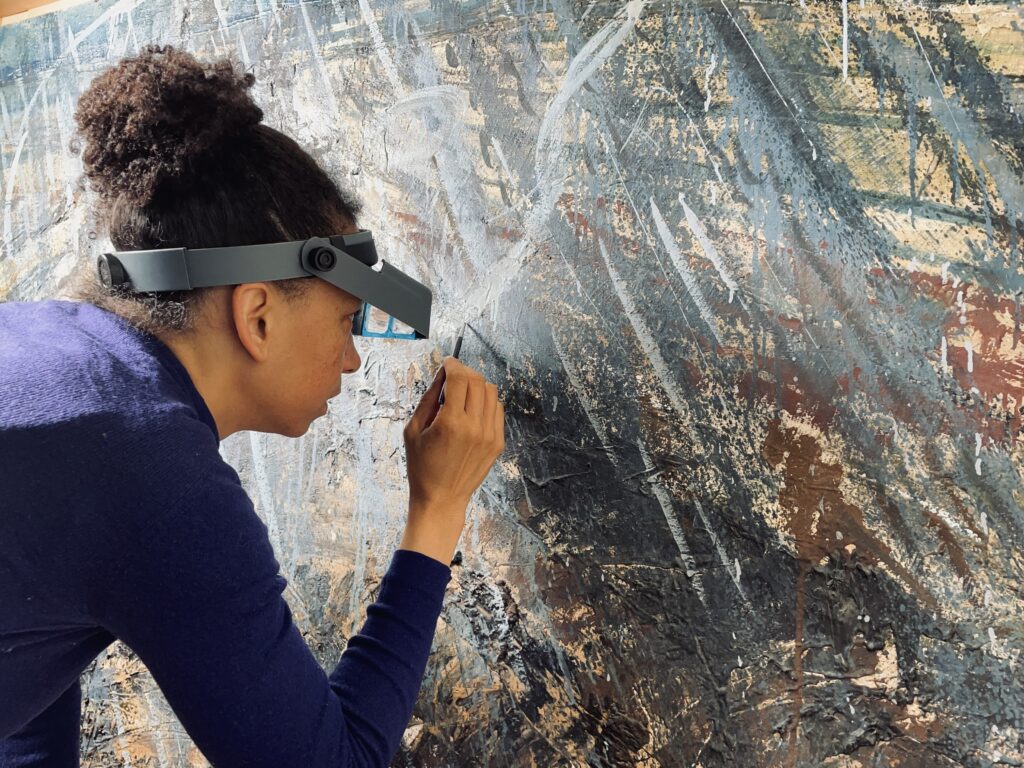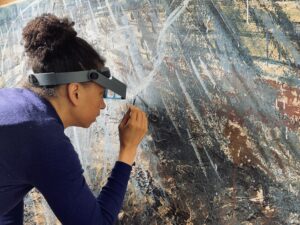Conservation of a Painting by Anselm Kiefer from a Private Collection
Anselm Kiefer remains one of the most intriguing contemporary artists. With several upcoming exhibitions around the world, his work is once again receiving widespread attention. The Netherlands, too, is the stage for remarkable exhibitions this year. In March 2025, the exhibition Sag mir, wo die Blumen sind opened at both the Van Gogh Museum and the Stedelijk Museum in Amsterdam. This exhibition features an impressive installation by Kiefer, inspired by the devastating impact of war and the transience of nature. His monumental and layered paintings, composed of materials such as lead, straw, sand, and paint, pose unique challenges for conservators. Recently, I had the privilege of conserving a painting by Anselm Kiefer from a private collection in my studio.
The Work: Malen
The painting I conserved is Malen (1974), an impressive piece from a private collection. It depicts a vast, barren landscape with the outline of a painter’s palette, within which the word malen (German for “to paint”) is inscribed. Almost the entire surface is covered with short blue brushstrokes, evoking the impression of a heavy rain shower. Remarkably, these strokes are the same color as the painter’s palette, suggesting a direct link to the act of painting itself. Just as rain nourishes a field, painting can breathe life into a representation of reality—or in other words, myths can shape our perception of the past. A recurring theme in Kiefer’s work is the role of myth in German history, a theme clearly present in this painting as well.
Object Details
Title: Malen
Year: 1974
Period: 20th century
Material: Oil on canvas
Dimensions: 117.00 x 261.50 x 11.00 cm (h x w x d)
Collection: Private collection
The Challenge of Kiefer’s Materials
The conservation of a painting by Anselm Kiefer is complex. His experimental techniques present significant challenges. On one hand, his use of materials and textures creates impressive layers in his work; on the other hand, these materials raise difficult conservation questions. The combination of organic and inorganic substances makes his paintings vulnerable to dust, flaking paint, and distortions due to environmental factors. In this case, it was crucial to consider both his unique use of materials and his artistic intent.
Comprehensive Condition Report
Before the actual restoration, a thorough condition report was conducted. This included:
- Documentation of critical points and fragile areas, using microscopic analysis to better understand the state of the paint and materials.
- Inventory of possible previous conservation efforts, to assess whether past interventions had affected the work’s stability.
- Assessment of dust and dirt accumulation, as Kiefer’s relief-like structures often trap dust in deeper layers.
Conservation: Cleaning and Stabilization
Following the condition report, the cleaning process began. Dust removal in a Kiefer painting is an extremely delicate procedure, requiring precise techniques. Excessive pressure or unsuitable methods can damage fragile fragments. Therefore, the surface was gently cleaned using soft brushes and micro-suction techniques.
One of the most important steps in this treatment was stabilizing loose layers of paint and material. This was necessary due to Kiefer’s use of thick impasto and vulnerable materials like straw and lead. A customized consolidation method was applied using a reversible adhesive, ensuring stability without altering the painting’s original appearance.
Art and Decay: A Deliberate Choice?
When conserving a painting by Anselm Kiefer, a fundamental question arises: to what extent is decay an inherent part of his art? Kiefer appears to embrace the impermanence of his materials, which presents ethical dilemmas for conservators. Should every loose fragment be fixed, or should the passage of time remain visible as part of the artwork?
After consulting the owner and following international conservation principles, a minimal intervention approach was chosen. Only the most fragile areas were treated to preserve the raw and expressive character of the work.
The Impact of Conservation on Experiencing Kiefer’s Art
Caring for a painting by Anselm Kiefer is not only about preserving a physical object, but also about respecting the deeper layers within his work. This project provided insight into the technical aspects of his art, while highlighting the importance of honoring his artistic vision throughout the conservation process.
With growing interest in his oeuvre, it is fascinating to see how museums and private collectors approach the preservation of these monumental works. This year, the Netherlands offers a unique opportunity to experience Kiefer’s work up close.
Visit Anselm Kiefer – Sag mir, wo die Blumen sind
The exhibition Anselm Kiefer – Sag mir, wo die Blumen sind is a collaboration between the Van Gogh Museum and the Stedelijk Museum Amsterdam and runs from March 7 through June 9, 2025. For the first time, both museums jointly present an extensive overview of Kiefer’s work. The Van Gogh Museum highlights Van Gogh’s influence on his oeuvre, while the Stedelijk Museum showcases all the Kiefers in its own collection, supplemented by new, never-before-seen works. A special combination ticket grants access to both venues.
The exhibition’s title refers to the well-known anti-war song and aligns perfectly with Kiefer’s themes of transience and the human condition. One of the highlights is a monumental new work, created especially for this exhibition, which covers the walls of the Stedelijk Museum’s stairwell. This exceptional exhibition offers deep insight into Kiefer’s artistry and the dialogue between his work and Van Gogh’s legacy.
Caring for and conserving one of Anselm Kiefer’s works was a remarkable experience and a valuable contribution to the preservation of his impressive oeuvre.
Atelier Iddi, Vleuten, Utrecht, NL – May 2025
Do you own a contemporary or historic painting in need of a condition report or conservation treatment?
Feel free to get in touch for a no-obligation consultation!







